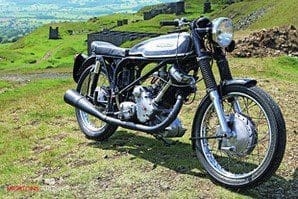
In the privileged life of working for Classic Bike Guide and riding other enthusiasts’ machines, the emphasis naturally leans toward the immaculate, the beautiful, the elegant, the award winners. Just as newspapers give pages and pages to the catwalk shows of leading designers and the latest fashion trends, in the classic magazine world we have a tendency to worship at the altar of the pristine. That means glorious pictures that make most of us jealous of the owner, and sometimes the bike’s riding performance matches up to its appearance…
However, that is not always so. I have called dealers who have loaned us bikes – if it’s a half decent bike they’re almost bound to sell it – and explained that I won’t tell lies. If it’s a dog, I will not say that it’s a real delight. A wise old journo’ told me never to underestimate the knowledge of the reader, and never to patronise him. So sometimes I don’t feel as enthusiastic as the pictures suggest, though I like to think honest reporting has reduced dodgy machines presented for a test. I was once offered an early Gold Star to parade at Beaulieu’s Motorcycle World. The carb flooded from a stuck float and oil leaked from the top end onto the Tarmac I was about to share with plodding tourers through to swift racers. At risk of offending the owner, I declined the ride.
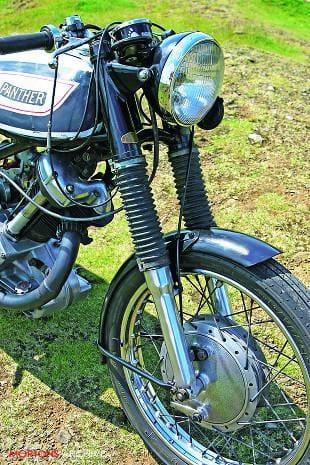 So when a bike comes along that I know has been put together from unlikely bits – that’s putting it mildly – by an ex racer and engineer with a wicked sense of humour, the state of the paintwork and not even the slightest nod at originality doesn’t matter. If the lack of polished alloy offends, blame me, because this motorcycle proves you can take the most unlikely bits and end up with a bike that is just Fun – with a capital F.
So when a bike comes along that I know has been put together from unlikely bits – that’s putting it mildly – by an ex racer and engineer with a wicked sense of humour, the state of the paintwork and not even the slightest nod at originality doesn’t matter. If the lack of polished alloy offends, blame me, because this motorcycle proves you can take the most unlikely bits and end up with a bike that is just Fun – with a capital F.
It’s Pete Howells’ Panther–Norton, a title that reflects its major constituent parts. Add in some unusual sources, like stainless tubes from a dialysis unit or what looks like a speedometer but is actually a pedometer from a Puch exercise bike, and you have a motorcycle that better do something well before it’s dismissed as just daft.
It began with one of those swap deals, where two mates have boxes of assorted bits they’re not sure what to do with, and decide that a change of assortments might trigger an idea. In Pete’s box he found a Featherbed frame from which some vandal had removed the duplex tubes from headstock to the gearbox. These missing major limbs were nowhere to be seen, so welding torch surgery was definitely not on the menu.
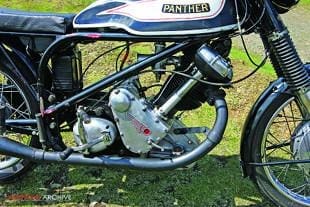 I had some connection with vintage racing years ago, and Pete asked if I recalled anyone racing a Panther engined Norton. If there had been such an aberration, he could build a replica and get a ride in what’s called Historic Racing today. I’d never heard of such a bike and a cursory look at such results as I could find revealed no clue. End of racing ambitions and time for a rethink.
I had some connection with vintage racing years ago, and Pete asked if I recalled anyone racing a Panther engined Norton. If there had been such an aberration, he could build a replica and get a ride in what’s called Historic Racing today. I’d never heard of such a bike and a cursory look at such results as I could find revealed no clue. End of racing ambitions and time for a rethink.
In the meantime, Pete had been up to the Bolton jumble and picked up a 1952 Model 100 Panther engine for an affordable price – please don’t ask, you could get seriously depressed, this was a while ago – then strapped it on the back of his BMW R80 and ridden triumphantly south.
The Featherbed’s lack of lower trellis work and bare tube ends was cured by taking a length of suitable size tubing to a local exhaust specialist to U-bend it so that the two ends roughly measured up to the standard Norton bottom cradle span. Pete welded it up. Integrated chassis integrity, I suppose you could call it, but in those days it was a right handy bodge. Still there, too.
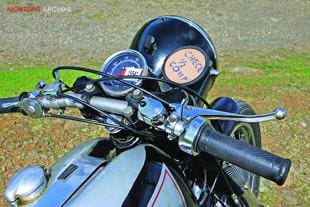 In its original form the bike was red. Jan Howells wanted him to paint it pink – for obvious reasons – but the West Mercia Taste Police got to hear about it and it ended up red. It wore a 17in Royal Enfield front wheel in that early form, because Pete had one, but as it evolved he swapped it for a Norton item and its respective better brake.
In its original form the bike was red. Jan Howells wanted him to paint it pink – for obvious reasons – but the West Mercia Taste Police got to hear about it and it ended up red. It wore a 17in Royal Enfield front wheel in that early form, because Pete had one, but as it evolved he swapped it for a Norton item and its respective better brake.
The original Model 100 600cc engine was swapped for the bottom end of a 1920s Royal Enfield V-twin, minus barrels and heads. With Pete’s ability to adapt the most unlikely parts that shouldn’t have been a problem, but the twin’s timing cover was akin to Old Mother Hubbard’s cupboard – bare. Making timing gear for an engine of which you have no knowledge is a whole new challenge, so Pete looked around for the easier option, another Panther engine. Off to the jumbles again, to turn up a Model 100 bottom end, a 650cc Model 120 conrod that was persuaded to fit and to top it a Volvo piston was machined to fit. As the piston cost a fiver, the trouble was arguably worth it. A 120 barrel cost him eight pounds and his search for the rare single-port head revealed an absolute bargain: “I couldn’t believe when I saw one at a jumble. I was prepared to pay £50 for it, but all he wanted was £12!” Well, in that circumstance you wouldn’t argue, would you?
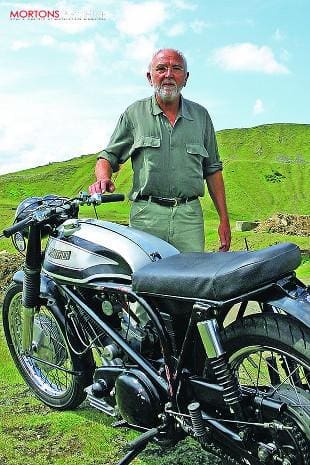 The lighting comes from a belt-driven generator few could identify, a Suzuki GP100 unit machined to fit and driven through an extension shaft and Ford pulleys. Never mind the offence this will give to the anoraks, the little Suzy was given to him; Mr Howells is not given to wasting money if he can adapt something that’s free. It passes the MoT too!. The forks are long Roadholders adapted to accommodate short Roadholder internals, while the primary chaincase is pure Howells: front curve from a Villiers 2T twin downpipe, the rear one from a C15 pipe and goodness only knows what provides the bit in between. I do know the neat bulge over the crankshaft end is the body of some redundant medical equipment Pete salvaged from the skip. He was a maintenance engineer at a hospital.
The lighting comes from a belt-driven generator few could identify, a Suzuki GP100 unit machined to fit and driven through an extension shaft and Ford pulleys. Never mind the offence this will give to the anoraks, the little Suzy was given to him; Mr Howells is not given to wasting money if he can adapt something that’s free. It passes the MoT too!. The forks are long Roadholders adapted to accommodate short Roadholder internals, while the primary chaincase is pure Howells: front curve from a Villiers 2T twin downpipe, the rear one from a C15 pipe and goodness only knows what provides the bit in between. I do know the neat bulge over the crankshaft end is the body of some redundant medical equipment Pete salvaged from the skip. He was a maintenance engineer at a hospital.
On the matter of adapting and fabricating, the bike wears the biggest black megaphone I’ve ever seen. We did check inside before firing the motor up, to ensure there were no illegal immigrants in there. They’d left already – must have been the early shift potato picking.
‘On the matter of adapting and fabricating, the bike wears the biggest black megaphone I’ve ever seen. We did check inside before firing the motor up, to ensure there were no illegal immigrants in there…’
Pete is a specialist in adapting parts and his home-built Citroen 2CV powered three-wheeler has the belt drive to its alternator hidden behind an Ariel primary cover. Behind that is a fine double curvature cover that started life as the top of the old copper water cylinder in the roof and the boot lid is a Morris Minor bonnet. Pete and Jan parked up to wait for the ferry to France, when the owner of a modern Morgan thanked them for bringing one of the early models to the Morgan rally he was going to. Nice try; it was built in Worcestershire.
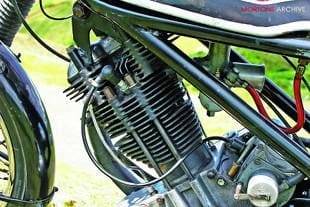 The Panther-Norton geometry has been sharpened up a mite since he first built the bike, by steepening the steering head angle. “I took the frame into work and cut a bit out of the top tube,” he explains. “Then me and my mate warmed the lower tubes with a welding torch on each side and moved it a bit. I welded a little bit into the top tube, then sleeved it as well, just to be sure.” He makes it sound like a quick lunch hour special, but it was a lot more than that, because beneath the man’s laid back attitude is an engineer who knows how to make things work properly.
The Panther-Norton geometry has been sharpened up a mite since he first built the bike, by steepening the steering head angle. “I took the frame into work and cut a bit out of the top tube,” he explains. “Then me and my mate warmed the lower tubes with a welding torch on each side and moved it a bit. I welded a little bit into the top tube, then sleeved it as well, just to be sure.” He makes it sound like a quick lunch hour special, but it was a lot more than that, because beneath the man’s laid back attitude is an engineer who knows how to make things work properly.
It had been stood for a few weeks when we called, and it showed its grumpy side by refusing to fire up. Muscle was the answer and we gathered together the mighty power of John Wilkinson and myself pushing, down the lane, into the pub car park and down the lane again to stir those Panther flywheels and get the electrics to spark the plug. Pop, pop, bang and action. That big megaphone exhaust didn’t seem to contain too many baffles…
If you know Panthers, particularly the well worn versions (aren’t they all?) you’ll know they run with generous clearances and mechanical clatter, though no more than you should expect from an iron head and barrel and a Volvo piston. Must blame Volvo if we can, you know.
It’s the sort of bike a racer put s together for his own amusement, with minimal expenditure. The seat accommodates one, so no need for pillion footrests. The handlebars are pretty much straights, the rider leans slightly forward, with air and ignition levers to tackle. The rear brake lever is tucked in tight, as should be but seldom are. I settled into the saddle, got extremities acquainted with their respective controls – they all fitted me naturally – and followed Pete and Wilko down the Worcestershire lanes.
s together for his own amusement, with minimal expenditure. The seat accommodates one, so no need for pillion footrests. The handlebars are pretty much straights, the rider leans slightly forward, with air and ignition levers to tackle. The rear brake lever is tucked in tight, as should be but seldom are. I settled into the saddle, got extremities acquainted with their respective controls – they all fitted me naturally – and followed Pete and Wilko down the Worcestershire lanes.
Those lanes aren’t as smooth as they once were, and the bike’s firm suspension exercised my kidneys in a way for which some would pay a personal trainer a lot of money. The bike was stable, easily changing its line around a corner if a patch of gravel left by the early summer rains came into view, responding positively to the rider’s wishes; not many personal trainers will do that!
The Panther engine has won a lot of fans over the years, and its reputation as sidecar hauler is justified by its ability to pull strongly from very low revs and shrug off hills. A club member once enthused about pulling a loaded trailer behind his outfit and building up a personal following as he cruised the A5 at 40mph. One suspects those following didn’t find it so funny. This particular power unit speaks basso profundo style through its megaphone exhaust and shows its gratitude for a lighter life by pottering along at walking pace with no protest in first gear, or digging its heels in and getting a move on when the throttle wire is tightened. Don’t ask what speeds we were doing, because I can only estimate 65-70mph max; remember where that speedo came from and don’t be surprised that it sits steadily on 33mph and doesn’t budge.
‘This particular power unit speaks basso profundo style through its megaphone exhaust and shows its gratitude for a lighter life by pottering along at walking pace with no protest in first gear, or digging its heels in and getting a move on when the throttle wire is tightened…’
The bike covers ground with little rider effort once it’s in top gear and rolling, with the ability to carry speed through corners and only back off a shade. The Norton gearbox does its job in an entirely predictable way – light pressure through a small arc of movement and the next gear is engaged, no problems.
It does turn heads though. That distinctive exhaust makes bike aware pedestrians look around to see what’s coming, the Norton rolling chassis looks like another Bracebridge Street single at 50 yards and then they see the sloping engine and wonder who did that, and how?
As Wilko was doing his close-ups, Pete repeated ‘don’t be frightened to give it some stick, as it’s a tough old thing.’ Come starting time, I lifted the half-time lever and it fired up first kick. When it came to the riding shots we were at Crumps Brook, once a famous trials section and now just an interesting swoop through a bridge over a stream; access to the scene of many past displays of riding skill is now blocked by wire fencing and the odd curl of barbed wire. OK, we take the hint we’re not welcome.
 Riding a strange machine back and forth through the same bend actually works out as a decent test of handling, because you become aware of the best line and any minor nasties to avoid. So I was putting the Panther through at what I thought was a fair pace, on a par with a well sorted Trident I rode over this same stretch some years back. It did just what I asked, didn’t move off the chosen line and the hard suspension was moving into the lower levels of its natural mode of operation, the speeds that Pete Howells normally uses.
Riding a strange machine back and forth through the same bend actually works out as a decent test of handling, because you become aware of the best line and any minor nasties to avoid. So I was putting the Panther through at what I thought was a fair pace, on a par with a well sorted Trident I rode over this same stretch some years back. It did just what I asked, didn’t move off the chosen line and the hard suspension was moving into the lower levels of its natural mode of operation, the speeds that Pete Howells normally uses.
At whatever rate you choose to ride this bike, it’s fun to know that someone can take an assortment of what many would dismiss as junk and turn it into a desirable, working motorcycle. Its effect upon the rider is to leave him with a grin. It’s the most fun I’ve had on wheels for years and Pete’s generosity extended to agreeing to let me take it to the Panther OC’s National Rally. I’ll certainly ride it there, but whether I’ll take it back to its rightful owner may be in doubt. Motorcycles should be fun – this is one hell of a fun motorcycle.



